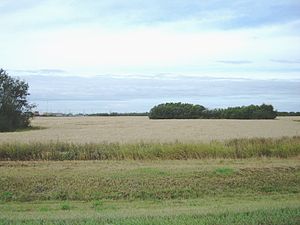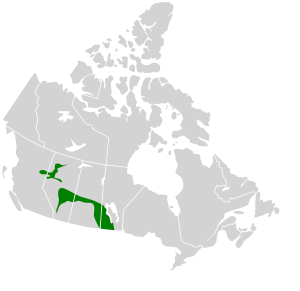Aspen parkland
| Aspen parkland | |
|---|---|

Parkland outside the city of Saskatoon, Saskatchewan
|
|

Aspen Parkland within Canada
|
|
| Ecology | |
| Biome | Temperate grasslands, savannas, and shrublands |
| Bird species | 206 |
| Mammal species | 72 |
| Geography | |
| Countries | Canada, United States |
| States/Provinces | British Columbia, Alberta, Saskatchewan, Manitoba and North Dakota, |
| Conservation | |
| Habitat loss | 63.76% |
| Protected | 2.95% |
Aspen parkland refers to a very large area of transitional biome between prairie and boreal forest in two sections, namely the Peace River Country of northwestern Alberta crossing the border into British Columbia, and a much larger area stretching from central Alberta, all across central Saskatchewan to south central Manitoba and continuing into a small part of the US state of Minnesota. Aspen parkland consists of groves of aspen poplars and spruce interspersed with areas of prairie grasslands, also intersected by large stream and river valleys lined with aspen-spruce forests and dense shrubbery. This is the largest boreal-grassland transition zone in the world and is a zone of constant competition and tension as prairie and woodlands struggle to overtake each other within the parkland.
This article focuses on this biome in North America. Similar biomes also exist in Russia north of the steppes (forest steppe) and in northern Europe.
According the Ecological Framework of Canada, published in 1999, the Aspen Parkland ecoregion (#156) is the largest and northernmost section of Prairies Ecozone. This definition is the arc-shapped region (i.e. including the WWF's central and foothills parkland but excluding the Peace River region). Partly, defined by climate, it had a mean annual temperature of approximately 1.5°C circa 1999, and rainfall varied from 400-500 mm/annum. It was thought to include the communities of Red Deer, Edmonton, Lloydminster, North Battleford, Humboldt, Yorkton, and Brandon, Manitoba as its major population centres and have a total population of 1 689 000. By this definition, there are approximately 5,500,000 hectares (14,000,000 acres) of this ecoregion in the province of Alberta.
...
Wikipedia
